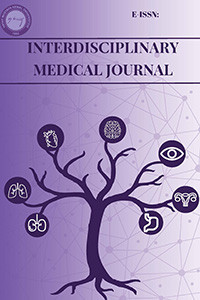ACÄ°L SERVÄ°SE BAÅVURAN 65 YAÅ ÃSTÃ HASTALARDA ABDOMÄ°NAL AORT ANEVRÄ°ZMA TARAMASI VE RÄ°SK FAKTÃRLERÄ°NÄ°N DEÄERLENDÄ°RÄ°LMESÄ°
abdominal aort anevrizmasÄą, tarama, yatak baÅÄą ultrasonografi
Evaluation of risk factors and screening of abdominal aort anevrism in patients admitted to the emergency department with over the age of 65
abdominal aortic aneurysm, scanning, bedside ultrasound,
___
- Hollier LH, Stanson AW, Gloviczki P, Pairolero PC, Joyce JW, Bernatz PE. Arteriomegaly:
- classification and morbid implications of diffuse aneurysmal disease. Surgery 1983;93(5):700-8.
- Melton LJ, Bickerstaff LK, Hollier LH, Van Peenen HJ, Lie JT, Pairolero PC. Changing
- incidence of abdominal aortic aneurysms: a population-based study. American J of Epidemiology
- ;120(3):379-86.
- Guirguis EM, Barber GG. The natural history of abdominal aortic aneurysms. American J of
- Surg 1991 ;162(5):481-3.
- Noel AA, Gloviczki P, Cherry KJ, Bower TC, Panneton JM, Mozes GI. Ruptured abdominal
- aortic aneurysms: the excessive mortality rate of conventional repair. J of Vascular Surg
- ;34(1):41-6.
- Charboneau JW, Rumack CM, Wilson SR. Diagnostic Ultrasound. 3rd ed. Philadelphia,PA:
- Elsevier Mosby; 2005. p.1905â40.
- KandiÅ H, KarakuÅ A, KatÄąrcÄą Y, Karabolat S, Kara Ä°H. Geriatrik YaÅ Grubu ve Adli
- Travmalar. Turkish J of Geriatri 2011; 14(3): 193-8.
- Satar S, Sebe A, Avci A, KarakuÅ A, İçme F. YaÅlÄą hasta ve Acil Servis. Ãukurova Ãni TÄąp
- Fak Derg 2004; 29(1): 43-50.
- KarakuÅ A, Yengil E, ArÄąca S, Zeren C, Ãevik C, Erden ES, Ãelik MM, Ãzer C. Huzurevi
- Sakinlerinin Acil HastalÄąklarÄąnÄąn DeÄerlendirilmesi. Turkish Family Phy 2012;3(3):16-22.
- Tintinalli J, Stapczynski J, Ma OJ, Cline D, Cydulka R, Meckler G. Tintinalli's Emergency
- Medicine: A Comprehensive Study Guide, Seventh Edition: Mcgraw-hill; 2010. p. 361-465.
- Wiesbauer F, Schlager O, Domanovits H, Wildner B, Maurer G, Muellner M, et al.
- Perioperative beta-blockers for preventing surgery-related mortality and morbidity: a systematic
- review and meta-analysis. Anesthesia and analgesia 2007; 104(1): 27-41.
- Force USPST. Screening for abdominal aortic aneurysm: recommendation statement. Ann of
- Int Med 2005;142(3):198-202.
- Wilmink TB, Quick CR, Hubbard CS, Day NE. The influence of screening on the incidence of
- ruptured abdominal aortic aneurysms. J of Vasc Surg 1999;30(6):203-8.
- Ashton HA, Buxton MJ, Day NE, Kim LG, Marteau TM, Scott RA. The Multicentre
- Aneurysm Screening Study (MASS) into the effect of abdominal aortic aneurysm screening on
- mortality in men: a randomised controlled trial. Lancet 2002;360(9345):1531-9.
- Fleming C, Whitlock E, Beil T, Lederle F. Primary Care Screening for Abdominal Aortic
- Aneurysm. Rockville; 2005. p.1-15.
- Simoni G, Pastorino C, Perrone R, Ardia A, Gianrossi R, Decian F, et al. Screening for
- abdominal aortic aneurysms and associated risk factors in a general population. European journal of
- vascular and endovascular surgery : the official journal of the Euro Soc for Vascular Surg
- ;10(2):207-10.
- Pleumeekers HJ, Hoes AW, Hofman A, van Urk H, van der Does E, Grobbee DE. Selecting
- subjects for ultrasonographic screening for aneurysms of the abdominal aorta: four different strategies.
- Int J of Epidemiology. 1999;28(4):682-6.
- Vardulaki KA, Walker NM, Day NE, Duffy SW, Ashton HA, Scott RA. Quantifying the risks
- of hypertension, age, sex and smoking in patients with abdominal aortic aneurysm. The British J of
- Surg 2000;87(2):195-200.
- Lederle FA, Nelson DB, Joseph AM. Smokers' relative risk for aortic aneurysm compared
- with other smoking-related diseases: a systematic review. J of Vascular Surg 2003;38(2):329-34.
- Wilmink TB, Quick CR, Day NE. The association between cigarette smoking and abdominal
- aortic aneurysms. J of Vascular Surg 1999;30(6):1099-105.
- Rodin MB, Daviglus ML, Wong GC, Liu K, Garside DB, Greenland P. Middle age
- cardiovascular risk factors and abdominal aortic aneurysm in older age. Hypertension. 2003;42(1):61-
- -
- Singh K, Bonaa KH, Jacobsen BK, Bjork L, Solberg S. Prevalence of and risk factors for
- abdominal aortic aneurysms in a population-based study : The Tromso Study. American J of
- Epidemiology 2001;154(3):236-44.
- Derubertis BG, Trocciola SM, Ryer EJ, Pieracci FM, McKinsey JF, Faries PL. Abdominal
- aortic aneurysm in women: prevalence, risk factors, and implications for screening. J of Vascular Surg
- ;46(4):630-5.
- YayÄąn AralÄąÄÄą: 3
- BaÅlangÄąÃ§: 2023
- YayÄąncÄą: Hatay Mustafa Kemal Ãniversitesi TÄąp FakÞltesi DekanlÄąÄÄą
LOMBER DÄ°SK HASTALARINDA AÅIRI AKTÄ°F MESANE SENDROMUNUN DEÄERLENDÄ°RÄ°LMESÄ°
GÃķkhan Arslan, Ali KarakuÅ, Koca ÃalÄąÅkan, Mustafa Åahan, Mehmet Duru, GÞven KuvandÄąk, Yakup ErdoÄan
NEURONAVIGATION: A REVOLUTIONARY STEP OF NEUROSURGERY AND ITS EDUCATION
S. BaÅarslan, CÞneyt GÃķçmez
Atilla Karateke, Raziye Kurt, Mehmet Dede, Ayhan GÞl, Ãetin KÄąlÄąÃ§, Defne Ãzkaya
Mustafa Ãzçil, Arif GÞngÃķren, Ali Hakverdi, Hasan GÃķkçe, Orhan Nural
NADÄ°R GÃRÃLEN BÄ°R BENÄ°GN YUMUÅAK DOKU TÃMÃRÃ; ELASTOFÄ°BROMA DORSÄ°
Ãmer YÄąldÄąz, Raif Ãzden, Ä°brahim Duman, Vedat Uruç, Yunus DoÄramacÄą, AydÄąner KalacÄą
Ahmet SÞmbÞl, Celal BatmacÄą
ISOLATED TRANSVERSE SACRUM FRACTURE AND ITS IMPLICATIONS: A CASE REPORT
